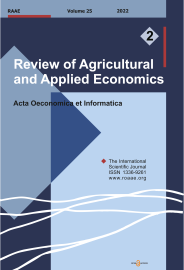KEYWORDS:
agrifood; food security; gender equality; inclusive; resilience
DOI NUMBER:
10.15414/raae.2021.24.01.98-108
ABSTRACT:
Research background: Strengthening agriculture and food systems have a critical role to play in achieving the sustainable development goals of eliminating hunger and poverty; and increasing resilience to climatic shocks. Crop diversification has been recognized as a way of increasing resilience and reducing agricultural risk. Closing the gender gap could boost agricultural productivity and enhance welfare. Effects of crop diversification in enhancing dietary diversity amidst gender gap in agricultural productivity among smallholders have not been well established in Nigeria.Purpose of the article: The study was conducted to provide empirical evidence on crop diversification, productivity and dietary diversity of male and female-headed farming households in Nigeria. This has policy implications on development of inclusive and efficient agrifood system towards achieving the SDGs of eradicating poverty, hunger and gender equality.
Methods: Secondary data from the 2015/16 Living Standard Measurement Survey-Integrated Survey on Agriculture (LSMS-ISA) was used for this study. Tobit regression model was employed to investigate the factors influencing crop diversification and dietary diversity while Oaxaca-Blinder decomposition method was used to decompose gender differentials in agricultural productivity.
Findings and value added: Crop diversification index of male farmers is 0.10 (P<0.05) higher than female farmers. The Tobit regression results showed that farm income, education, household size, farm size and use of inorganic fertilizer increased crop diversification (P< 0.01). However, household expenditure (p< 0.05), non-farm income (p< 0.1), age and credit access (P< 0.01) reduced crop diversification. Less than half (45.22%) of the rural households consumed at least nine out of the 12 food groups in the previous week of the survey period. Crop diversification among other factors has a positive (P<0.01) effect on households’ dietary diversity. The results of the Oaxaca-Blinder decomposition showed a gender productivity gap of 10.87% in favour of male farmers. The structural and endowment disadvantages of female farmers in land size and credit access are key drivers of gender differentials in agricultural productivity. The study suggests improvement in land tenure system and female farmers’ access to financial services in order to ensure gender productivity equality, women empowerment and efficient agrifood system.
Please Cite this Article as:
Adekemi OBISESAN, David AWOLALA (2021) Crop Diversification, Productivity And Dietary Diversity: A Gender Perspective. Review of Agricultural and Applied Economics. XXIV (Number 1, 2021): 98-108. doi: 10.15414/raae.2021.24.01.98-108
URL for sharing:
https://roaae.org/1336-9261/doi/abs/10.15414/raae.2021.24.01.98-108
FULL TEXT PDF:
▼ direct download link| view online in fullscreen ▲
References:
▼ direct download link

